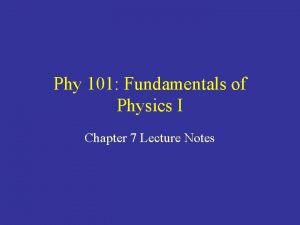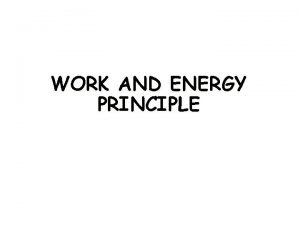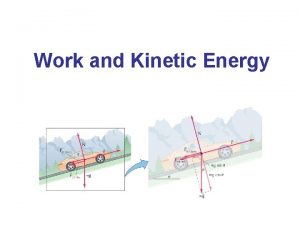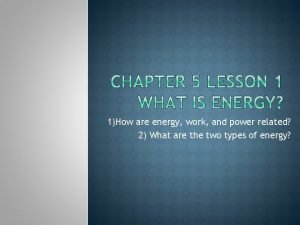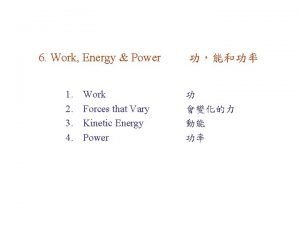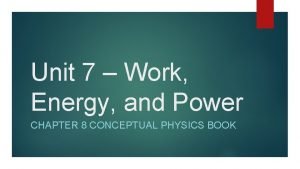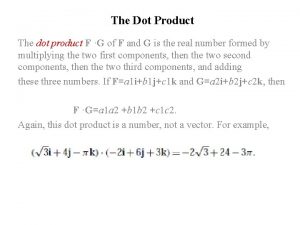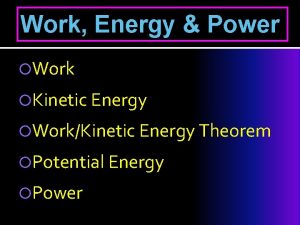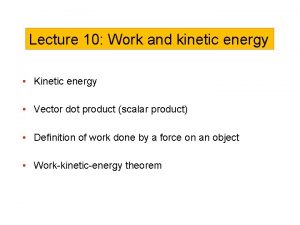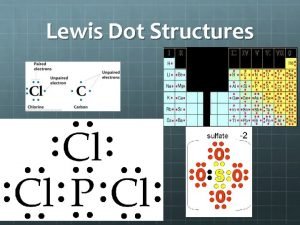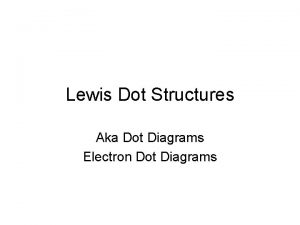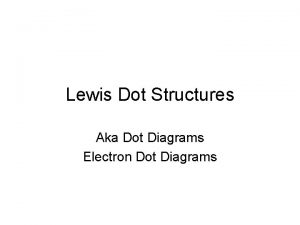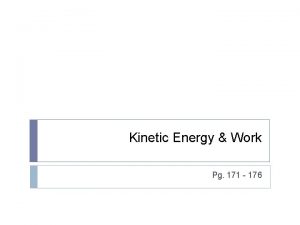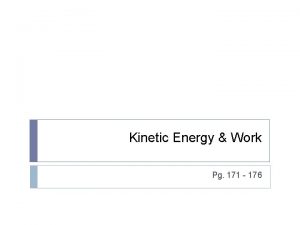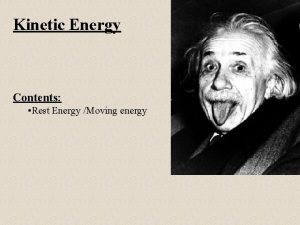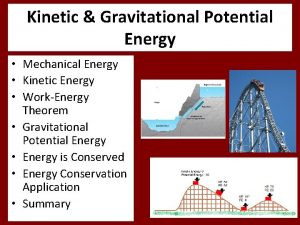Energy Kinetic Energy Work Dot Product and Power




























- Slides: 28

Energy, Kinetic Energy, Work, Dot Product, and Power 8. 01 W 08 D 1 Fall 2006

Forms of Energy • kinetic energy • gravitational energy • elastic energy • thermal energy • electrical energy • chemical energy • electromagnetic energy • nuclear energy • mass energy

Energy Transformations • Falling water releases stored ‘gravitational potential energy’ turning into a ‘kinetic energy’ of motion. • Human beings transform the stored chemical energy of food into catabolic energy • Burning gasoline in car engines converts ‘chemical energy’ stored in the atomic bonds of the constituent atoms of gasoline into heat • Stretching or compressing a spring stores ‘elastic potential energy’ that can be released as kinetic energy

Energy Conservation • Energy is always conserved • It is converted from one form into another, from an “initial state” to a “final state” • Energy can also be transferred from a system to its surroundings

Kinetic Energy • Scalar quantity (reference frame dependent) • SI unit is joule: • Change in kinetic energy:

Concept Question Compared to the amount of energy required to accelerate a car from rest to 10 mph (miles per hour), the amount of energy required to accelerate the same car from 10 mph to 20 mph is (1) the same (2) twice as much (3) three times as much (4) four times as much

Kinematics: Recall Integration Formula The x-component of the acceleration of an object is the derivative of the x-component of the velocity Therefore the integral of x-component of the acceleration with respect to time, is the xcomponent of the velocity Multiply both sides by the mass of the object

Kinematics: An Integral Theorem for One Dimensional Motion The integral of x-component of the acceleration with respect to the displacement of an object, is given by Multiply both sides by the mass of the object

Newton’s Second Law: An Integral Theorem for One Dimensional Motion Newton’s Second Law If F is not constant, then (in one dimension), Therefore the integral theorem coupled with Newton’s Second Law becomes

Work Done by a Constant Force for One Dimensional Motion Definition: The work W done by a constant force with an x-component, Fx, in displacing an object by x is equal to the xcomponent of the force times the displacement:

Work done by Non-Constant Force for One Dimensional Motion (Infinitesimal) work is a scalar Add up these scalar quantities to get the total work as area under graph of Fx vs x :

Work-Kinetic Energy Theorem for One Dimensional Motion Work-energy theorem is the statement that the work done by a force in displacing an object is equal to the change in kinetic energy of the object

Concept Question Consider two carts, of masses m and 2 m, at rest on an air track. If you push one cart for 3 s and then the other for the same length of time, exerting equal force on each, the kinetic energy of the light cart is (1) larger than (2) equal to (3) smaller than the kinetic energy of the heavy car.

Concept Question A particle starts from rest at x = 0 and moves to x = L under the action of a variable force F(x), which is shown in the figure. What is the particle's kinetic energy at x=L/2 and at x=L? (1) (Fmax)(L/2), (Fmax)(L) (2) (Fmax)(L/4), 0 (3) (Fmax)(L), 0 (4) (Fmax)(L/4), (Fmax)(L/2) (5) (Fmax)(L/2), (Fmax)(L/4)

Concept Question When a person walks, the force of friction between the floor and the person's feet accelerates the person forward. The floor does (1) Positive work on the person (2) Negative work on the person (3) No work on the person

Power • The average power of an applied force is the rate of doing work • SI units of power: Watts • Instantaneous power

Dot Product A scalar quantity Magnitude: The dot product can be positive, zero, or negative Two types of projections: the dot product is the parallel component of one vector with respect to the second vector times the magnitude of the second vector

Dot Product Properties

Dot Product in Cartesian Coordinates Example:

Work Done by a Constant Force Definition: Work The work done by a constant force on an object is equal to the component of the force in the direction of the displacement times the magnitude of the displacement: Note that the component of the force in the direction of the displacement can be positive, zero, or negative so the work may be positive, zero, or negative

Work as a Dot Product

Concept Question: Work A ball is given an initial horizontal velocity and allowed to fall under the influence of gravity, as shown below. The work done by the force of gravity on the ball is: (1) positive (2) zero (3) negative

Concept Question: Work A comet is speeding along a hyperbolic orbit toward the Sun. While the comet is moving away from the Sun, the work done by the Sun on the comet is: (1) positive (2) zero (3) negative

Work in Three Dimensions Let the force acting on an object be given by The displacement vector for an infinitesimal displacement is The work done by the force for this infinitesimal displacement is By Newton’s Second Law

Three Integral Formulas for Three- Dimensional Motion Recall Repeat the argument for the y-direction And for the z-direction Adding these three results gives the work done in moving an object from A to B

Work-Energy Theorem in Three-Dimensions Recall From Newton’s Second Law the infinitesimal work is Therefore Work-Energy Theorem

Appendix: Work Done Along an Arbitrary Path

Appendix: Line Integrals • force vector • line element • total work: Denote A by and B by
 Kinetic energy is dot product of
Kinetic energy is dot product of Id root
Id root Power is equal to the dot product of force and: phy101
Power is equal to the dot product of force and: phy101 Cross product outer product
Cross product outer product Lima buah vektor digambarkan sebagai berikut
Lima buah vektor digambarkan sebagai berikut Rumus perkalian silang
Rumus perkalian silang Ads=vdv example
Ads=vdv example When does mechanical energy change
When does mechanical energy change Work done and kinetic energy
Work done and kinetic energy Energie cinetique
Energie cinetique Potential energy of spring
Potential energy of spring Potential energy
Potential energy Conservation of mechanical energy
Conservation of mechanical energy Closed dot in graphing inequalities
Closed dot in graphing inequalities Chapter 4 work and energy section 1 work and machines
Chapter 4 work and energy section 1 work and machines Spring potential energy
Spring potential energy Mechanical energy pics
Mechanical energy pics Gravitational potential energy vs kinetic energy
Gravitational potential energy vs kinetic energy Kinetic energy to thermal energy
Kinetic energy to thermal energy Potential vs kinetic energy
Potential vs kinetic energy The real lesson 21
The real lesson 21 Dotnet vs java
Dotnet vs java Work, power and energy activities
Work, power and energy activities Define work done
Define work done How are energy work and power related
How are energy work and power related Work power energy and machines
Work power energy and machines W=fdcosθ meaning
W=fdcosθ meaning Work power
Work power Unit 7 work energy and power answers
Unit 7 work energy and power answers


